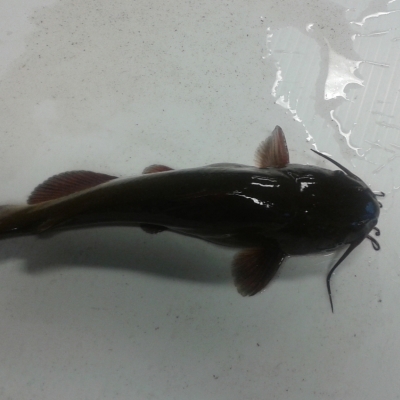- Our Lakes
- Cleaning up our lakes
- Lake Updates
- Who we are
- Resources
- Competition
- Contact


18 March 2016
One catfish was caught and a second one seen during weed harvester work at Te Weta Bay, Lake Rotoiti last Wednesday. The caught catfish is 26cm long and thought to be a pest species known as brown bullhead catfish (Ameiurus nebulosus).
Bay of Plenty Regional Council Biosecurity Manager Greg Corbett said that the pest find is very disappointing.
“Catfish have become widespread in Waikato waterways, including Lake Taupō. We’ve done dive and net searches for catfish before in response to reported sightings in Lakes Tarawera, Ōkāreka and Rotoiti, but this is the first time a live catfish has been found in the Bay of Plenty. A dead one was found on the shoreline at Lake Rotoiti in 2009,” he said.
Mr Corbett said together with Department of Conservation and Fish and Game NZ, his staff will now search for more catfish so they can ascertain how widespread the problem is and explore feasible control options.
“We’ll be working with stakeholders such as Te Arawa Lakes Trust and technical experts from NIWA and the University of Waikato as we progress that work,” he said.
The catfish were found by Bay of Plenty Regional Council contractors who were clearing weed to help improve water quality in the lake.
“It’s a surprising find, given Regional Council has worked hard to keep new pests out of the Rotorua lakes through regular surveillance and public advocacy. Catfish can be difficult to detect at low densities. Lake Rotoiti was last checked for catfish earlier this year and none were found,” Mr Corbett said.
While large trout may feed on them, catfish are an unwanted pest because they feed on small native fish, trout and their eggs. Catfish also compete for food with other native species, including koura (freshwater crayfish). In high numbers, catfish can degrade water quality when they stir up sediments to feed, making water murky and unpleasant for lake users and wildlife.
Mr Corbett said there’s an historic account of an accidental live catfish transfer into Lake Rotoiti approximately 20 years ago. The latest find may have been a deliberate release or the result of accidently transfer as fish eggs on weed fragments attached to an unclean boat, trailer or other water sports equipment.
“This highlights the importance of checking and cleaning all equipment before using it in a different waterway, every time. The public can help us to manage this problem by being vigilant about equipment hygiene and reporting any cat fish or other pest sightings or illegal releases to us by calling 0800 STOP PESTS (0800 786 773).
Further information about freshwater pests, including catfish is available at www.boprc.govt.nz/aquaticpests
Where are catfish from?
Brown bullhead catfish (Ameiurus nebulosus) are native to North America. They were introduced into New Zealand in 1877.
What do catfish look like?
Where are they found?
Catfish are generally found in slow or still freshwater environments though they are adaptable and can inhabit most freshwater systems. They can survive for very long periods out of water and are tolerant of poor quality environments.